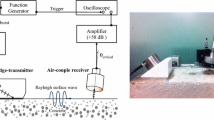This study discusses ultrasonic and impact-echo methods as the most common nondestructive methods for determining concrete durability based on sound vibration velocity. It also reveals the influence of the signal of an acoustic surface wave on the accuracy of measuring resonant frequency in the spectrum of a cubic compact concrete sample. A through-transmission impact method is proposed to measure sound vibration velocity in cubic test concrete samples and determine concrete durability via an acoustic nondestructive method. An impactor and a receiving transducer are placed on opposite sides of the cube, several measurements are made at different positions of the impactor (or receiving transducer), and results of partial measurements are subjected to multiplicative processing to eliminate sound vibration and reduce errors in determining concrete durability.



Similar content being viewed by others
References
V. I. Korobko and A. V. Korobko, Quality Control of Building Structures: Vibroacoustic Technologies, Izd. ASV, Moscow (2003).
K. B. Sanish and Manu Santhanam, "Characterization of strength development of concrete using ultrasonic method," 18th World Conf. on Non-destructive Testing, Durban, South Africa, April 16–20, 2012, pp. 110–120.
M. Brigante and M. A. Sumbatyan, “Acoustic methods in non-destructive testing of concrete: a review of international publications in the field of theoretical research,” Defektoskopiya, No. 4, 3–16 (2013).
M. Brigante and M. A. Sumbatyan, “Acoustic methods in non-destructive testing of concrete: a review of international publications in the field of experimental research,” Defektoskopiya, No. 2, 52–67 (2013).
M. Sansalone and W. B. Streett, Impact-Echo: Nondestructive Testing of Concrete and Masonry, Bullbrier Press, Jersey Shore, PA (1997).
N. J. Carino, "Impact-echo: the fundamentals," Int. Symp. on NDT in Civil Engineering (NDT-CE), Berlin, Germany, Sept. 15–17, 2015.
J. K. Zhang, W. Yan, and D. M. Cui, Sensors, 16, No. 4, 447 (2016), https://doi.org/10.3390/s16040447.
T. Epp, D. Svecova, and Y. J. Cha, Sensors, 18, No. 4, 1018 (2018), https://doi.org/10.3390/s18041018.
R. Zhang, L. D. Olson, A. Seibi, et al., "Improved impact-echo approach for non-destructive testing and evaluation," Proc. 3rd WSEAS Int. Conf. on Advances in Sensors, Signals and Materials, Jan. 2010, pp. 139–144.
V. K. Kachanov, I. V. Sokolov, A. A. Samokrutov, et al., “Construction of the dispersion dependence of the correction coefficient for the control of compact products of square section by the impact-echo method,” Defektoskopiya, No. 1, 3–14 (2021).
V. K. Kachanov, I. V. Sokolov, S. A. Fedorenko, and S. V. Lebedev, “Application of the impact-echo method for measuring the sound velocity in cubic test specimens made of concrete to determine its strength,” Izmer. Tekhn., No. 2, 42–45 (2018).
A. C. Jording, Damage Detection in Metamorphic Stone Blocks Utilizing Impact-Echo Testing and Modal Analysis, Student Research, University of Nebraska-Lincoln (2012).
Ninel Alver and Masayasu Ohtsu, “Dynamic boundary element method analysis for determining correction factor in impact echo, transportation research record,” J. Transport. Res. Board, No. 2050, 122–126 (2008).
Author information
Authors and Affiliations
Corresponding author
Additional information
Translated from Metrologiya, No. 2, pp. 31–43, April–June, 2021. Original article submitted November 12, 2020.
Rights and permissions
About this article
Cite this article
Kachanov, V.K., Sokolov, I.V., Samokrutov, A.A. et al. Through-Transmission Impact Method for Measuring Sound Vibration Velocity in Compact Concrete Cubic Samples. Meas Tech 64, 511–515 (2021). https://doi.org/10.1007/s11018-021-01961-x
Received:
Published:
Issue Date:
DOI: https://doi.org/10.1007/s11018-021-01961-x




